Baptists
BAPTIST CHURCHES ESTABLISHED IN NEWHAM
In chronological order, with founding name and post office district
1852 STRATFORD GROVE E15
1870 - 1917 STRATFORD TABERNACLE E15
1871 BARKING ROAD TABERNACLE E13
1880 WOODGRANGE E7
1883 - 1976 UPTON CROSS E7
1885 STRATFORD NEWTOWN E15
1887-1974 WYTHES ROAD, SILVERTOWN E16
1888 - 1978 NEW BECKTON E6
1889 LITTLE ILFORD E12
1889 MANOR PARK TABERNACLE E12
1895 EAST HAM TABERNACLE E6
1900 - 2001 GRANTHAM GOSPEL MISSION E12
1903-1939 WEST SILVERTOWN E16
1906 CUSTOM HOUSE E16
1908 BONNY DOWNS E6
1994 CALVARY CHARISMATIC E13
1997 VICTORY LIFE E7
1998 ROYAL DOCKS COMMUNITY CHURCH E16
2001 ALL NATIONS E12
2001 - 2007 HARVEST ROCK E7
2003 VICTORY E7
2006 BISERICA ROMANA E15
2008 I HOPE E7
2014 INTERNATIONAL PRAISE CENTRE
Bow Baptist Church looks across the traffic to the Olympic Park and the Stratford sky-line. The new building is in the East London Borough of Tower Hamlets, the birth- place of all British Baptists. The very first congregation gathered in Spitalfields in 1612. The Strict Baptists followed at Wapping in 1638. Leaders from Bow Baptist crossed the Lea to link with both the Plaistow Union Church, established with the Congregationalists in 1796, and then the Stratford Baptists from the 1850s.
In Stratford the first of a group of 15 Baptist churches followed the massive increase in population as London spread eastward and industries covered the banks of the Thames and the Lea. By 1903 5351 Baptist worshippers using 14 buildings in the County Borough of West Ham were recorded in The Religious Life of London. 10 of the older churches are still here. A second, very different, group of Baptist churches followed from the 1990s as immigration brought many nations-and faiths- to East London. 8 new church plants have begun and after mergers, moves and closures 5 continue into 2019.
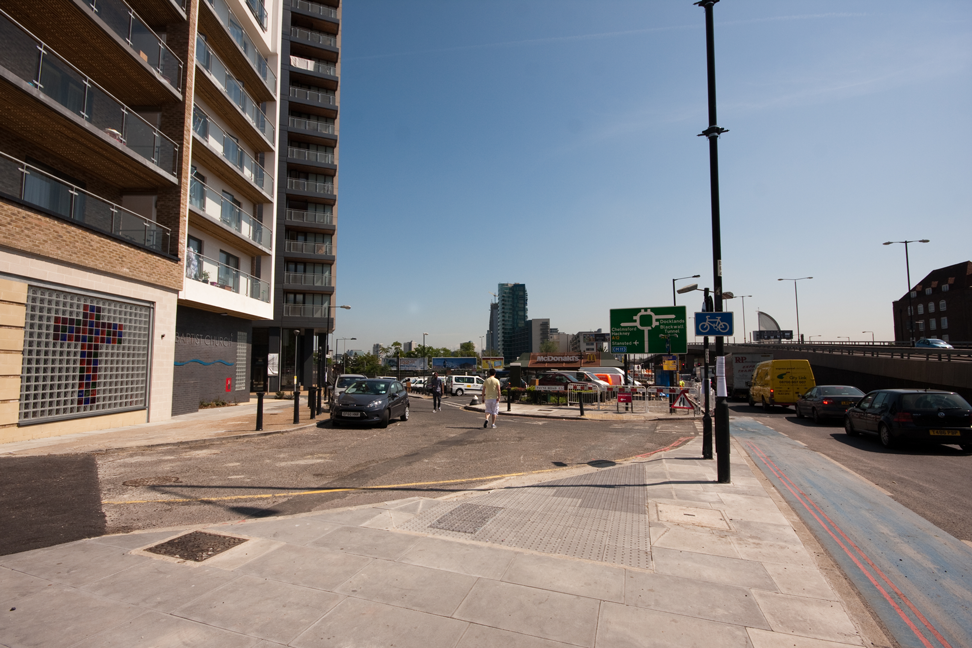

SETTLING IN STRATFORD
The first established Baptist congregation in Newham appeared in Stratford in 1852. This NW corner of the Borough is now dominated by the 2012 Olympic Park and Westfield. It was originally marshland, crossed by the London-Colchester Roman road and ruled for 300 years by the 12th Century Stratford Langthorne Abbey. The area changed dramatically from the mid-18th Century as industrialisation covered the area with roads, factories, railway yards and dense housing.
STRATFORD CENTRAL E15 was the first of three Baptist congregations established here between 1852 and 1885. 'Its career has been one of continual effort in the midst of somewhat difficult circumstances' reported the Stratford Express in 1889. The church faced the Roman Catholic St Francis and the Anglican St Johns. The nearby Martyrs Memorial lists 18 Protestants who were burnt to death in 1556.
The history of the church is outlined in We've a Story to tell -an outline of the church's story from its humble beginnings 150 years ago to the present day which marked the 150th Anniversary in 2002. A group first met in 1852 at 'The Yorkshire Gray' in Stratford High Street and started services in Rokeby House, Broadway in 1853. In 1854 the site on the corner of Stratford Grove was purchased and the STRATFORD GROVE church was built in 1855 with a Sunday School hall added in 1861. The building, seating 400, had a central, high pulpit backed by an organ facing rows of pews and an upstairs gallery with a side hall for Sunday School and weekday meetings. The stained glass windows have a cross with the Spurgeons College motto-Et Teneo Et Teneor-Holding I am held'.
The Stratford Express recorded early details: 'the Rev G Fishbourne was pastor of the Baptist Church at Bow, a church founded on what is known as the "closed communion" principle. Mr Fishbourne was desirous of introducing a change in the constitution of the church by substituting "open" for "closed" communion... The Bow church refused....and he resigned. Mr J Freeman, of Stratford, was at that time a member of the church at Bow, and he fully sympathized with Mr Fishbourne's "open communion" views. The result was that Mr Fishbourne removed to Stratford, and in conjunction with Mr Freeman and others, originated the movement which is an open communion church with a Baptist pastor'.
Fishbourne and Freeman were among the initial trustees: 'Ebenezer Clarke [gentleman], Robert Whall Cooke [gentleman], the Rev George Fishbourne [Baptist minister], Joseph Freeman [schoolmaster], George Gould [gentleman], Anthony and William Hudson [grocers], Robert and Christopher Terry Robins [merchants], Andrew Trimen [architect] and Matthew Cape Witty [schoolmaster]' .
George William Fishbourne, 1853-66 was the founding minister and was followed by two short ministries- A Curr 1866-68 and C F Vernon 1868-73. The congregation grew under J H Banfield 1875-93, who founded two West Ham charities to help with poverty and unemployment, J C Hewison 1893-95 and W H Stevens 1895-1909, but membership then fell rapidly under George Sneesby 1909-13 and Thomas Williams 1913-17. The names, photographs and dates of all the ministers are on display in the church-some called Rev and others Pastor, with a few wearing a 'dog-collar'.
In 1917 the church was renamed STRATFORD CENTRAL when the neighbouring Stratford Tabernacle, with their minister W Percy Hicks joined . The work initially flourished but declined from the 1920s. A series of short ministries led the congregation through the dropping population and the 1939-45 war and its consequences- R C Bradbrook 1925-30, Percy H Crunden 1931-37, Henry Bryant 1928-42, Hubert V Little 1943-48, Douglas G Millar 1951-56, C W A Brown 1957-61 and Leslie Beckingham 1962-65. W Bannerman-Fletcher then had a joint Pastorate with Alders-brook 1969-72. Lay-pastors followed in Ken Saunders, previously lay-pastor at Grantham Gospel Mission, 1976-2002 and David Orange 2003-10 who became a part-time minister.
Damaged in the 1939-45 war the church emerged as the only Free Church survivor of the large Methodist, Congregational and Presbyterian congregations in The Grove and Maryland areas. The `Central News' magazine was revived in 1956 and still had a circulation of 350 in 2002. Membership dropped to 139 in 1941 and to 52 in 1961 but rose again through immigration to 79 in 1991 and 85 in 2011. In 2002 it was noted- 'The roots of many originate from the West Indies, Sri Lanka, Ghana, Nigeria, Hong Kong, Singapore, Portugal, Sierra Leone, India, Malaysia, Eire and Scotland'
The original building still stands on a busy road fenced in by iron railings, with a small garden and a notice board - Come and worship God with us. Jesus cares about you and so do we'. One of the new Baptist congregations, the Romanian Biserica Baptista Harul, have shared the premises since 2006. A new chapter began for Stratford Central when Dele Oke, a former Ichthus pastor, was called to be minister in 2012.
STRATFORD TABERNACLE Carpenters Road E15. The district was the home for over 1000 businesses known as the 'land of a thousand smells' as leather-workers, paint makers, rag dealers, pie and sauce works vied with Yardley's perfume factory. The old district with its crowded streets and factories bounded by the Lea, canals, railways and the busy Al2 was replaced with post-war housing and new industries but has now been swallowed up by the Olympic Park.
The Tabernacle was a church for its time and district, it lasted for 47 years, has now disappeared and few notes remain. It was probably founded by Dr Gratton Guiness of Harley College, Bow.
The work began in 1870 in rented premises in Barnby Street. In 1877 a church seating 800 was built in Carpenters Road and had congregations of 200+ under the first minister, G W Towner 1877-90. The local Board school was used for the large Sunday School between 1885 and 1890. Numbers began to fall after 1900. J Creer 1900-07 and H J Watts 1910 were the ministers followed by W P Hicks 1913-22, who was also editor of the Christian Herald. As membership continued to drop and people moved away from a noisy, polluted district Hicks led the remnant of the fellowship to join The Grove church and the two congregations became Stratford Central. The Tabernacle buildings were sold to the YMCA but then destroyed in the 1939-45 war.
MAJOR ROAD STRATFORD E15 was first known as NEWTOWN. The district in north Stratford faced the sprawl of the Great Eastern Railway marshalling yards which once dominated the area which is now covered by Westfields and the Olympic Park.
The church is a tenacious, independent, family-strong church that has never had a large membership but has rooted locally and been a 'stepping stone' for both ministers and a transient community. Archives and Our Story so far put together in 1973 by Frank Savidge, a life-long member and deacon, record early milestones and personalities.
Newtown began in 1885 with a large building erected at the corner of Crownfield Road- the site is marked on the 1894 Ordnance Survey map. A lecture hall was added in 1900 and this is now the home of the Major Road church. T Maycock 1885-96, W K Chaplin 1898-1907 and M M Thomson 1907-09 were the first ministers. The church had financial struggles in the 1900s which required denominational assistance.
In 1907 a mission hall of Cann Hall, Leytonstone joined with Newtown and their pastor M M Thomson took over the united church, with the name changed to MAJOR ROAD, but internal division led to the church being dissolved and re-started with a very small membership in 1909.

Short ministries and lay-pastorates with long intermissions and the 1939-45 war marked the first half of the 19th Century. Among the listed leaders are J D Howell 1910, W E Notman 1914-20, J J Harding 1925-29, Bernard Reading 1939, Mr Haines, W R J Stokes 1949 and Brian Green 1953.
The original church building was bombed in 1941 and then demolished. Worship continued in the Newtown Hall which was re-built, restored and re-opened in 1953 with a series of crusades.
Gerald Shaw in the early 1960s was followed by Robert McGrann 1965-70 and Eric Dewhirst from 1972. A fresh approach followed with Michael Hearn 1980-89 and Charles Homer 1990-91 as part of a team trained by Humphey Vellacott of East Ham. David Brownutt 1993-2000 was the last full-time minister. Elders and deacons have led the church from 2000. Membership figures were 34 in 1941, 42 in 1961 and then dropped to the mid-20s from 1981 but rose to 36 in 2011.
Through the decades of change family connections have persisted- they include the Parsons, Bates, Savidge, Edwards, Chaplins, Sims, Barham and Norfolk. Evangelistic crusades and tent missions have run alongside the services, Sunday School, Christian Endeavour, Boys Brigade and Girls Brigade, Womens Meeting and Young Peoples Fellowship.
Immigration has brought new life and leadership alongside the 'anchor' members. Current leaders include Zambian, Indian and Nigerian in-comers. Another of the new London Baptist churches, The Faith Temple Mission, led by Obeg de Lawrence, used the premises from the 1990s-reporting a membership of 70 in 2001.
STIRRINGS AND STRUGGLE IN PLAISTOW
To the south of Stratford the small village of Plaistow became home to a notable group of Quakers from the 1670s and was visited by John Wesley three times in 1739- 'most of the hearers were very quiet and unconcerned. In the morning, therefore, I spoke stronger words. But it is only the voice of the Son of God who is able to awake the dead'. From the 1850s this obscure agricultural community saw great population growth that over-ran the 'genteel residences' inhabited by the gentry and wealthy City merchants. Dense housing, unemployment and poverty and political turmoil marked the district- Keir Hardie was elected here as first Labour MP in the UK in 1892 and West Ham became the first Labour Council in 1898.
In Plaistow Baptists had joined with Congregationalists in a Union Church from 1796. A break away from this church in 1871 led to the Baptist section joining the LBA under the leadership of F E Trotman 1871-73, meeting in Upper Road but vanishing by 1877. Other short-lived Baptist causes around the Barking Road were led by E Henderson 1871, J E Cracknell 1858-59 and J Hardwicke from 1859. W H Bonner 1863-64 hired West Ham Public Hall in the Barking Road before moving on to Powis Road, Bow. In 1863 W Palmer from Cotton Street, Poplar built and owned Mount Zion Chapel in Barking Road which closed soon after his death in 1867- Carey Bonner was baptized there and went on to become secretary of the National Sunday School Union and then President of the Baptist Union- the first of four to come from Plaistow. After Palmers death in 1867 the congregation moved to a room or barn in Anne Street before most transferred to the Strict Baptist Providence Chapel in Shirley Street. The Mount Zion premises were re-opened by H E Lister in 1871 and a new church called the Barking Road Tabernacle was formed there in 1872. The Mount Zion premises were later sold, became a Labour Hall, and were destroyed in the 1939-45 war.
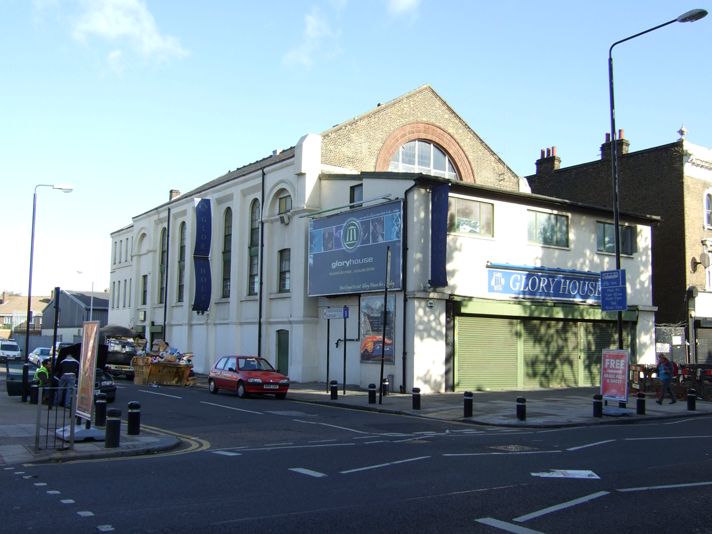
BARKING ROAD TABERNACLE E13. Now taken over by Glory House, a large independent black-led church, the Barking Road Tabernacle [The Tab] was birthed in struggle. R H Gillespie 1872-89 was minister when the building was opened, with continuing debt, in a district of unemployment and social difficulties. The short and spaced pastorates of G H Can 1889 and G T Edgeley 1893-96 followed. Then this failing church in a poor district, led by the Rowntree Cliffords, became a strong local congregation from which sprang West Ham Central Mission Church and Mission activities have been centred in two buildings.
`The Tab' housed the congregation and its developing programmes until the new building called West Ham Central Mission was opened in 1922/3 further down the Barking Road. The Tab then housed the Children's Church 1926-54 and became a war-time centre 1939-45. Outside swung, like inn signs, two pictures by Harold Copping-' Christ, Saviour of the world' and `Jesus calling the children to Himself' After sale in 1954 The Tab became the HQ of Waide Pollard, a chain of clothing stores, before being reclaimed by Glory House in the 1990s.
A second building, seating 2000, and known as WEST HAM CENTRAL MISSION, was opened in 1922/3 after 15 years preparation for 'a great cathedral church towering above the mean streets of West Ham, witnessing to the love of God and welcoming, as to a house of beauty and peace, burdened and weary hearts'. 80 foundation stones around the walls name churches and individuals across Britain and overseas who supported the venture. A peal of bells in one tower- a 1914-18 war memorial- rang for services.
This church has housed 1,000 strong Sunday congregations and a 2,000 strong Women's Meeting. It has hosted three broadcast services- including the-wartime 1944 series- and the first ever televising of a baptism. Borough and Remembrance services held here culminated in the 1965 Civic service for the founding of the London Borough of Newham that united West and East Ham. A strong musical tradition saw Ted Parker, Director of the Newham Academy of Music, serving as organist and choir master, for 50 years.
Robert Rowntree Clifford 1897-43, with his wife Hettie, revived and transformed the church fellowship, established a dynasty lasting 57 years, and founded a Mission. By 1900 all The Tab debts were cleared and 139 new members, including 82 baptisms, had joined the church as the Sunday School grew to 500. A growing church with rapidly expanding programmes to meet the poverty and social needs of the area led to the formation in 1904 of West Ham Central Mission which was to run alongside the church under the Superintendent Minister until 1965. Robert Rowntree was joined by his wife Hettie, sister Mary. brother Ernest, and then sons Paul and Hugh.
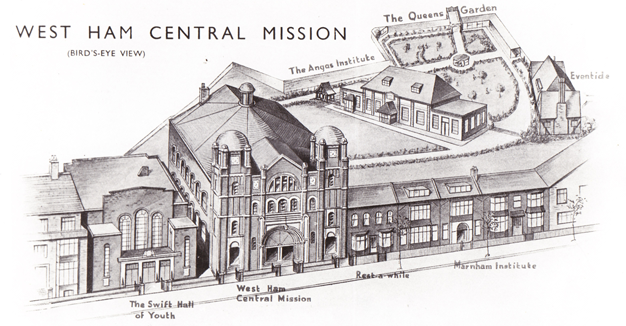
The 'birds-eye-view' tells the story of the inter-twined work of church and Mission in Plaistow. The church is surrounded by the Hall of Youth, Rest-a-While home for women, Marnham Institute housing workers, Even-tide home for men, Angas Institute for men and the Queens Gardens. The Mission also watched over 4 branch churches. Venture in Faith by Paul Rowntree Clifford 1951 and The Mission-Commemorating the last 100 years by David Pears 2005 have the full account of a famous institution that grew out of a church.
Teams of ministers, deaconesses and 'volunteers' working in both Church and Mission grew rapidly. The 1932 report speaks of 5 ministers and 22 women staff. Ministers included R Ronald Williams 1906, A J Billings 1910-13, W S Lord 1914-33, E O Clifford 1920-29, C G Hutchinson 1922, Bill Bodey from 1929 and David Tait Patterson from 1933. Women, led by the redoubtable Hettie, had key roles. The Order of Baptist Deaconess, founded in 1890, sent Sisters including Hettie 1905, Amy and Ellie 1907, Mabel and Sheila 1908, Clara 1913-20, May 1914-29, Vera 1917-38, Marjorie Griffin, Hilda, and, later Megan Davies and Joy Baines. Muriel Forrest and Gladys Bodey gave a life-time of service and their names were later commemorated in Forrest House and Bodey House. Dr Powell, the local GP; Bill Beagles, the Scoutmaster who went on to lead Orchard House, and Ivor Morgan, the Company Secretary of Ford Motor Works and deacon and secretary of West Ham Church Council were among the members. Tom and George Neal and Edwin Robertson all entered the Baptist ministry from the church.
Paul Rowntree Clifford 1938-54 followed his father as Superintendent-Minister in 1943 and worked in Plaistow with Dennis Lant 1941-47, Hugh Rowntree Clifford 1942-50, Albert Oakley 1944-50 and Rex Mason 1951-54.
Throughout the opening years of the 20th Century the church grew. In 'The Tab' growing congregations were joined by the Womens Meeting on Monday that began in 1904- '500 assembled on that first day...within a few months the membership increased to 1450' It was led by Hettie for over 40 years and claimed to be the largest ever Women's Meeting in 1927 with 2485 members when 47 coaches were needed for the annual Southend outing. The Mens Meeting, on Sunday afternoons from 1904, soon reached 800. An Institute in the old manse led to Evening Classes, Band of Hope, Lads Rally, PT and an Invalid Kitchen. Peoples Services, the Forward Movement and visiting evangelists led to conversions- 550 were recorded in 1912. The Sunday School was 2000 in 1907 and the Girl's Meeting 800 strong in 1918.
Robert Rowntree Clifford became national BU President in 1933. An Appeal letter from him in 1937 said that the church was running Sunday Schools, Bible Classes, Christian Endeavour Societies, Women's Meeting, Creche, Men's Meeting, Young Men's Brotherhood, Men's Social Club, Lad's Club, Working Girl's Meeting, Open Air Work, Girl Guides, Girl's Life Brigade, Boy Scouts, Band of Hope, Maternity Care, Rescue Work, Relief Work' Membership peaked in the 1930s, was 1087 in 1941 and 886 in 1951.
Stanley Turl 1954-78 followed Paul Rowntree Clifford as Superintendent Minister of both the local church and the wider Mission. David Staple 1955-58, Stuart Fuller 1958-61 and Norman Barr 1962-65 were assistant pastors. Sister Daphne Pearce 1954-2003 was joined by Anne Green and Sylvia Owen in 1970-all becoming ordained ministers from 1975 as the Deaconess Order ended. `White flight' from the district and membership pruning cut membership from 886 in 1951 to 486 in 1961. Four uniformed groups-Scouts, Guides, BB and GLB and an Open Youth Club catered for the young. The Womens Meeting, led by Olga Turl, the remnant of the Mens Meeting and the Diamond Fellowship for OAP's launched by Daphne Pearce in 1955 watched over the elderly.
In 1965 Colin Marchant came to be the minister responsible for the local congregation, allowing Stanley Turl to concentrate until 1978 on the wider and developing work of WHCM which saw International House, Rowntree Clifford Close sheltered housing for the elderly and York House operating in Plaistow with Greenwoods Country Centre and Orchard House for boys in Stock, Essex. Between 1965-70 the church launched the Mission in Friendship visitation campaign, house groups, play groups, holiday schemes and '409 Club' and 'Melting Pot' youth groups. Judith Marchant started under-5 work with a playgroup before opening Children and Family Centres in the 1970s.
In 1978 a new trust deed which legally separated the local congregation from WHCM changed the name of the church to MEMORIAL BAPTIST CHURCH PLAISTOW. During the decade 1965-75 117 new members joined the church, 47 by baptism and 54 by transfer over against a 290 loss by death and the moving out of the white population.
Throughout the 1970s the church had team ministries linking the Plaistow, Custom House, New Beckton and Poplar and Berger churches with Lawrence Hall, a residential and community centre led by Colin Marchant. Youth ministers John Jones and Stewart Culbard together with Richard Walker from 1974 and Sylvia Owen shared the ministry. Members of the church were involved in the community through Newham Social Worker's Group, Newham Education Concern , Manor Road Adventure Playground, Newham Churches Dockland Group and the Samaritans. Gathering concern for the inner cities throughout the 1980s saw Colin Marchant become chair of the national Evangelical Coalition for Urban Mission, General Manager of Aston Charities and then Baptist Union President 1988-89.

The early 1990s were difficult years in the church. A return to solo ministries began with Chris Morgan, who resigned in 1991 and Sue Wilson from Spurgeons College followed. By 1993 there were 70 members and no full-time minister. Accelerating immigration led to a wave of black churches and the premises were shared with 5 West African and a Filipino congregations. Asylum seekers, refugees and poverty led to NOSH- Newham Organised for Stopping Hunger-on the premises. Alongside the church, the WHCM work, led by Trevor Davis 1978-91, was in difficulties with changing social patterns and fmancial pressures that saw York House close. Eventually WHCM was centred in three counselling centres in Chelmsford, Basildon and Plaistow and became a new charity in 2001
Mark Janes, 1996-2019, wrote What happened next? Venturing in Faith 2004 The history of the Memorial Church 1953-2004. Church premises were used as a Night Shelter for the homeless and NOSH and shared with the London-wide Ethiopian Church, Christ Mission and the Apostolic Church. The Girls Brigade closed in 2003 and the Boys Brigade in 2005. The church hosted two BBC Songs of Praise in 1999 celebrating ' 60 years since the end of the blitz' and 'The East End Today'. Street Pastors for Newham was launched from the church by Osabo Otaigbe in 2006/7.
In 2006 the congregation was joined by the independent and nearby St Andrews and the two became MEMORIAL COMMUNITY CHURCH in 2007. Membership consequently rose from 58 in 2001 to 100 in 2011. Steve Acott, leader of St Andrews, shared in the ministry before his sudden death in 2010. His wife, Julia, brought Alternatives, a work among women and families, to Forrest House in 2011 as the WHCM Counselling centre closed.
A congregation of 120, with a third under 18, now has the Swift Centre with 100 young people and the homeless charity Bridges running the Welcome Centre in its programme. The restoration of bells and the tower in 2011 was noted in the Baptist Times headline 'Restoring the Past. Building the Future' together with the statement: 'The original vision of the church, that was at the heart of WHCM, was to share the gospel in very practical ways that addressed the needs of the people who were very poor. The church continues to work with people who are vulnerable and socially excluded.....The church as a family of people wants to be at the heart of our local community offering people the opportunity to discover who Jesus Christ is and the transforming power of His love'.
CONTINUITY AND CHANGE IN FOREST GATE
WOODGRANGE Romford Road Forest Gate E7 began as a 'suburban' church on the edge of Wanstead Flats, grew rapidly to over 1000 members, slowly declined through population movement, welcomed the Caribbean immigrants and continues to be a 'standing firm' significant, congregation.
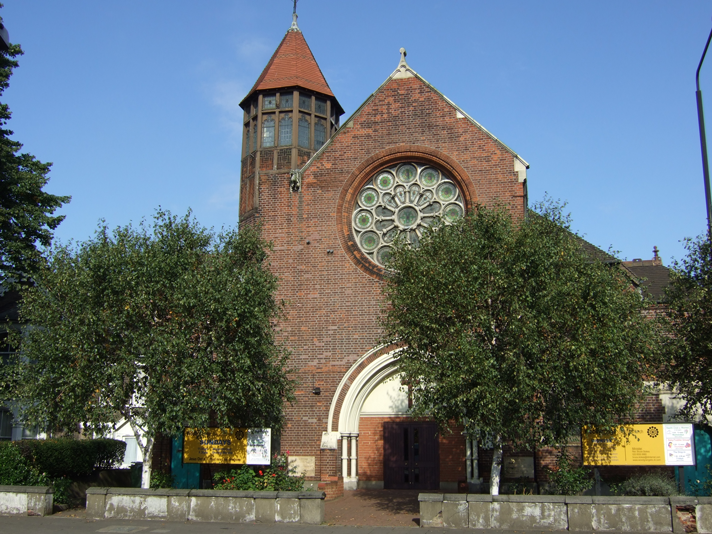
The church began life in 1880 in Workmans Hall. A builders hut used by the workers on the developing Woodgrange estate. It became the LBA 1880 'Chapel of the Year' and in 1882 a building seating 950 opened on the present site with 57 members.
The Woodgrange Chapel Centenary 1882-1982 has the opening appeal for funds:
`the local committee [LBA] respectfully appeal to the generosity of Christian friends to sustain them in seeking to meet the religious necessities of the multitudes who are swarming out to these vast Eastern suburbs....They have undertaken the responsibility in the firm conviction that it is a real work for God. There are no wealthy Baptists on the spot. There are the numbers sufficient to support a place of worship when erected; but they have not the means, unaided to erect one'.
The local Trust Deed and conveyance:
`to erect thereon a chapel and other buildings for the use of a Society or Congregation of Protestant Dissenters who shall or may attend the Worship of God at the said chapel, maintaining the sole authority of the Holy Scriptures, in every matter of faith and practice and that interpretation of the Holy Scriptures which is usually reputed Evangelical....'
And the 1883 Covenant -still in use in 1982-stated:
`We, as members of the Church of Christ, having been brought by the will of God to worship together in Woodgrange Baptist Church, hereby make covenant together. As a Church of Jesus Christ, we will, from this time forth endeavour to bear one another's burdens, and to rejoice in one another's welfare; we will strive together for the Faith of the Gospel, and we will seek to walk together in the way of the Lord. We will also labour, as far as lies in our power, to extend the Kingdom of God in this neighbourhood, and we promise to contribute in proportion to our means to the support and advancement of the cause of our Redeemer. Further, we will welcome to our fellowship brethren in Christ who shall comply with the conditions of membership. Finally we will watch and pray, on the common behalf, that as a Church we may be like a light shining in a dark place, and, as individuals, the faithful and persevering followers of our Lord Jesus Christ'.
J H French 1882-1917 presided over the building of the church in 1882, the initial covenant, the first baptismal service in 1883, and the adding of halls and classrooms in 1889. A special service was held in 1892 to 'celebrate the completion of the chapel and the commissioning of the new organ'. In 1901 the church was enlarged and by 1903 was the strongest Baptist church in the former West Ham County Borough. French served locally on the Board of Guardians and the West Ham School Board and became President of the LBA in 1903. He publicly shared in the protest against the imposition of a rate for church schools in 1903 and was taken to court and fined. During his ministry over 1400 members were received into the church including Nurse Gertrude Jacques who went to China in 1916 as a Medical Missionary.
Thomas Powell 1918-28 saw 283 members enrolled and a Manse at 146 Claremont Road purchased. Thomas Thornton 1929-33 died in office having set up the Wednesday Evening Bible School, seen the start of the Boy's Brigade and received 71 members. Tudor Rhys 1934-38 and Eric Wood 1939-56 were there for the difficult war and post-war years- the church and ancillary buildings were damaged in air raids but the Keswick Convention at Woodgrange in 1942 drew 1100 and the Woodgrange Messenger was first published in 1947. Thomas Caldwell 1956-59 received 27 members.
In Looking Back-Growing up in East London 1918-1938 Eric Dawson, a member and deacon of Woodgrange, tells of going to Woodgrange with his aunt and uncle ---`Their pew was in a conspicuous position right at the front, under the eyes of the choir and with a good view of the organist, who apparently writhed in discomfort as she led the singing'. Revealing pictures of 'A Sunday School Anniversary' and' Baptism by full immersion' are included in the book.
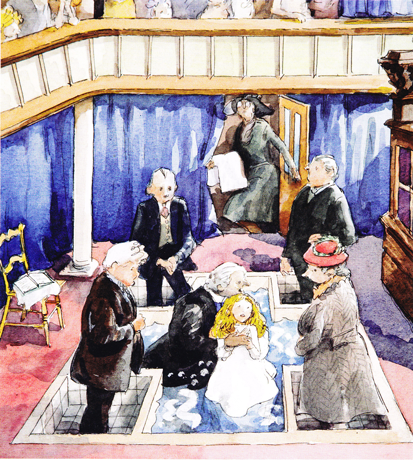
Baptism by total immersion
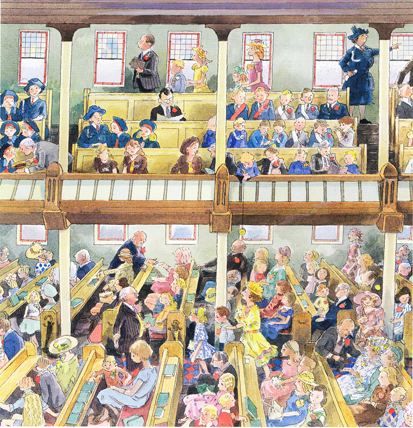
The Sunday School Anniversary, Woodgrange Baptist Church
Dennis Horwood 1960-69 had a pivotal ministry as Caribbean immigrants settled in Forest Gate. `A minister whose church is making a significant contribution to racial harmony and understanding in the Borough' said the Newham Recorder in 1969. Heckford Sharpe became the first black deacon and in 1963 became assistant minister after trying to found his own church- 'I planted the `Eastern Overseas Baptist Church' in the East End of London, because many overseas people, Jamaicans in particular, complained that they were not feeling welcomed in the white congregations'. Woodgrange linked with the Anglican Emmanuel and the Forest Gate Methodist churches in 1962 to form Tri-Jo youth work and Vivienne Baggs joined the team in 1966.
Douglas Hollidge 1969-2004-who became President of the LBA in 1991-2- led the church into the community during a time of transient population as asylum seekers and refugees arrived.. He launched a Stewardship campaign in 1970, saw 345 Romford Road become the manse in 1971, and led much church adaptation and community involvement. A play group in 1970, Gateway [a disability group] in 1984, Night Shelter for the homeless in 1994 and an Oasis team from 1989 used the buildings alongside the longstanding uniformed organisations and church groups. By 1980 the old church was re-modelled with services moved to the rear hall and a Woodgrange Centre opened. In 2000 the first floor level of the original building was re-furbished and opened for worship.
When the Upton Cross church closed in 1976 the deacons and members merged with Woodgrange. The area was changing rapidly and African, Indians, Koreans and Eastern Europeans were in the congregation by the 21st Century
Bruce Stokes came to the church-now surrounded by a mosque, McDonalds and hotels- in 2006 and set about re-development. A Parish Nurse, Noreen Gilhespy, joined him in 2008. A monthly forum 'Thinking Allowed' tackled contemporary issues. In 2010 two of the new Baptist churches, Victory and a branch of Calvary Charismatic began to use the premises alongside Eastside Young leaders Academy. In 2011/12 the church raised £160,000 for major re-development of the rear of the premises.
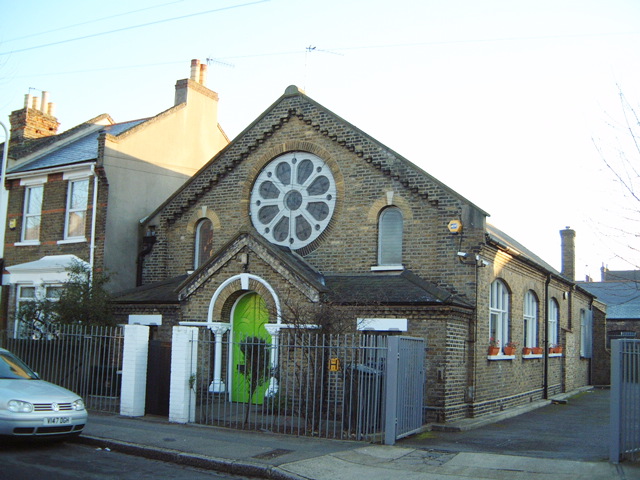
This building in Neville Road E7 was the home of UPTON CROSS BAPTIST CHURCH. Here a small congregation struggled, turned to others for help, never became fully independent and finally closed controversially, selling its building- initially to a Dr Barnados nursery school and then to a Sikh Gurdwara.
The work stemmed from the missionary work of the Independent Methodists who gathered a small congregation in East Road in 1883. A church was built in 1883 to seat 300 at the corner of Neville Road and Upton Lane E7 facing West Ham Park and housed a Baptist congregation until 1976. Known ministers included J Wilkinson 1883-1906, C Dudley 1910-17, J Bell 1919 and A Griffiths from 1925.
Although the church continued to retained its autonomy through the 1930s, Bill Bodey was seconded from West Ham Central Mission in 1930. Upton Cross then had close connections with Stratford Central in the 1940s and then from the 1950s returned to West Ham Central Mission, whose annual reports listed Upton Cross among four branch churches. Students from Spurgeons College and lay-preachers also served the church. Membership was 46 in 1951 with Sister Ann Davis of WHCM oversighting. Sunday School work and a Women's Meeting continued throughout the history of the church. But dropping membership with 44 in 1961 and 28 in 1971 as the white population moved away led on to closure in 1976 with the remaining deacons and members joining the nearest Baptist church at Woodgrange.
The closure and sale by the LBA and the Property Board was publicly challenged by Dr Clifford Hill of the Newham Community Renewal Programme at a time when local Christians were beginning to open their premises for community work and immigrant Caribbeans were starting to establish their own congregations. But the site was sold on to Dr Barnados for a nursery school and is now occupied by the Ramgharia Sikh Gurdwara.
UPS AND DOWNS IN EAST HAM AND MANOR PARK
East Ham and Manor Park was a sparsely populated district with two 12th Century Anglican churches covering the area until 1852. Growing population along the main Romford and Barking Roads, two railway lines. and the great docks to the south led to four very different congregations beginning here between 1888 and 1900-Little Ilford, Manor Park, East Ham and Grantham Gospel Mission.
LITTLE ILFORD TABERNACLE Manor Park E12 began in 1889 and has worshipped in four different buildings on two sites. Tucked into the NE corner of Newham it has held on, often helped by neighbouring congregations. A building in High Street North/Salisbury Road erected in 1895 was burnt down in 1897 but immediately re-built. The congregation moved east to Little Ilford Lane in 1900 and began with an iron building which was replaced by a permanent church seating 400 in 1905 which was demolished around 1980. Post-war development led to a new building in Sheringham Avenue in 1957 set in a high-rise estate and alongside the Romford Road. Unusually, the church features a 'Pilgrims Progress' mural.

A Winding Way 1889-1989, by Kenneth Bennett includes some revealing and succinct comments on the ministers. John James Nelson from East London Tabernacle, untrained and working in a solicitor's office, inaugurated work in Manor Park in 1889 which led to both Little Ilford and Manor Park Tabernacles. He was minister 1891-1910 and gathered 200 members, erected the first buildings and sent three men into the Baptist ministry. Joseph Rigden Green followed 1911-1916 and had four children, all of whom became missionaries or ministers. Alfred James Brown 1917-24 was 'an evangelical preacher and his sermons were well prepared' Wallis Arthur Coventry 1925-30 was 'a faithful pastor, a diligent visitor and a good student'. Charles Ayton Williams 1931-35 'went out of the Baptist ministry'. George William Yaxley, with a war-time ministry in 1939-42, was not replaced.
Membership in 1910 was in the 'region of 200' but dropped in 1935 to 111 and in 1939 was 45 and dropped in the war years to 21. The death of the long-term Church Secretary, Harry Yeomans, by 'enemy action' removed the key-leader.
After the war the short ministry of Harry Stoner 1946-48 and weak membership of 24 led to the Eastern Group of the LBA mounting a rescue operation by providing a lay-pastor, Percy J Radcliffe 1948-51 from Cranbrook; a secretary, Harold E Jones, from High Road, Ilford and two deacons in Thomas Adderkin from Ashhurst Drive, Ilford and Kenneth Bennett from Seven Kings.
The first woman leader, Deaconess Monica McFall, led the church 1953-57 when membership grew from 20 to 60 with an evening congregation of 100 and the stone-laying of the Youth Hall [later to become the church] took place. Three short pastorates- lay-pastor A T Wicks 1957-59 and ministers M G Baker 1959-62 and D C Potter 1963-66 maintained ministry and membership. Kenneth Bennett returned as Moderator 1966-70 when a membership of 40 was served by student pastors from Spurgeons College until 1979. Stuart Clarke 1979-82 came as minister and lifted the membership from 18-29 but from 1982 the church was lay-led by the deacons and by 1989 membership had dropped to 10.
The present leader, Mike Tuttiet, heard an appeal for help in High Road, Ilford in 1986, became a member of the Little Ilford Church in 1987, joined the leadership team in 1988 and became part-time pastor in 2000. It is now a 'church of local people for local people' with a multi-cultural congregation of 45 adults and children running the Ark Toddler Group, Women's Keep Fit and Horizon Arts alongside the church programme.
Manor Park Christian Centre was originally MANOR PARK TABERNACLE E12. Old notes and photos put together by Eddie King note that the church had the same founder-minister as Little Ilford Tab in John James Nelson but had a very different pattern. The church has swung from suburban stolidity through struggle for survival to charismatic cosmopolitan.
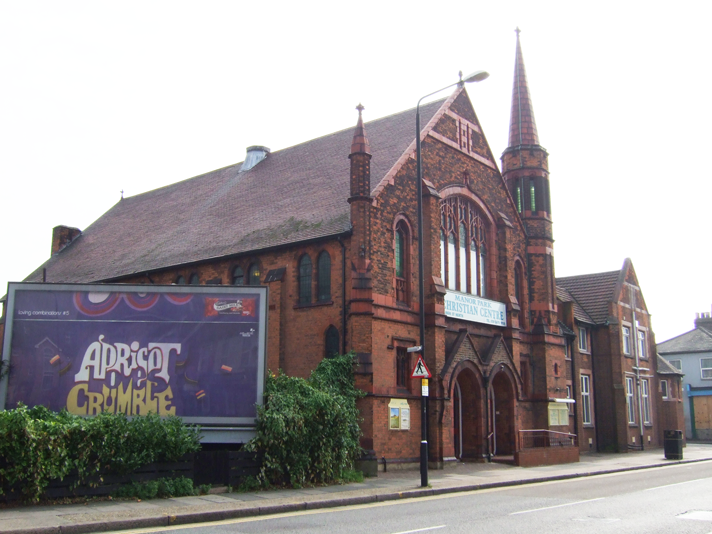
In 1889 the initial congregation met in a classroom in Carlyle Road school, then in the 'Gospel Shop' in the Romford Road 1890-93, followed by the former Congregational church in Greenhill Grove 1893-98. As membership grew baptisms took place at Woodgrange . In 1897 the church formed a building committee and bought five plots of land on the corner of High Street North and Berkeley Road. On this site an iron church opened for worship in 1898. The congregation grew in numbers and a new and larger church was built on adjoining land and opened in 1906 with seating for a 750 'mixed congregation'- Sunday School Halls followed in 1925.
A steady succession of ministers for nearly a century included F D Robbins 1889-98, Charles Pummell 1898-1904, R A Belsham 1905-08, C S Morgan 1908-17, P J Smart 1917-23, A J G Hipperson 1923-50, B J Moore 1950-59, W Bannerman Fletcher 1962-64, George Stirrup 1965-71 and G M Watson 1974-86.
The activities of a busy church were recorded in the magazines- Manor Park Baptist Recorder 1909, Church Magazine 1918 and Tabernacle Mirror 1927. They included a 'missionary-minded' football team in 1911 alongside a tennis club, netball team and cricket club. The 1914-18 war weakened the church and it never returned to its strength. In the 1920s house-to-house visitors went to a 100 homes a week in the surrounding 2000 homes. The 1939-45 war affected the church with evacuation, bomb damage in 1940 and 1942 and the take-over of the Sunday School Hall by the local authority which was not handed back until 1953. Membership figures continued to drop from 310 in 1941 to 43 in 1981. An uneasy relationship with the LBA and BU developed from the late 1960s after the publication of the Baptists and Unity Report —and the church withdrew from the BU.
Major changes began in 1984 when an independent Tamil speaking church, led by Ebby Ebenezer and Jonathan Eden, began to meet in the side hall as the main church building was derelict. They have continued to share the building and developed a network of branch churches. Members and a choir from this congregation sang in their own language in the BBC Songs of Praise 1987. Then in 1986 'the East London Christian Fellowship with a congregation of about 120 people were invited to join Manor Park Baptist Church who were then struggling with a very small congregation of faithful people who were praying that the church would be full again' Led by John Ivinson, this group was a 'break away' from the Assemblies of God in Plashet Grove who had been meeting in the Green Man pub.
MPBC became the MANOR PARK CHRISTIAN CENTRE led by John Ivinson with George Watson, the last of the accredited Baptist ministers, staying on as part of the leadership team until his death in 1993. Neil Osborne 1989-99 followed John Ivinson, then Eddie King 1991-2002 took over until David L Foster came from the USA to become senior elder [pastor] in 2002.
In the last 25 years the main church buildings have been modernized and made 'user-friendly' and now house two different growing congregations and a host of weekly activities. In 2006 'many different nationalities, cultural backgrounds including Asian African, Afro-Caribbean, British and European' made up a membership of 225 led by David Foster and five assistants.
EAST HAM BAPTIST TABERNACLE Plashet Grove E6 began in 1895 when the LBA promoted services in East Ham, then a fast growing dormitory suburb. The church has known the suburban-urban-cosmopolitan changes and experienced a growth-decline-resurrection pattern.
A temporary building at the corner of Katherine Road and Victoria Avenue housed the first congregation and R Sloven 1896-1908 became the first minister. In 1901 the church moved to a new building in Plashet Grove with a 1000 seater sanctuary surrounded by halls and rooms. By 1903 membership was 972 and it was one of the strongest churches in the Borough of East Ham. In 1908 Charles Howe, a member of the church, began work in the daughter church at Bonny Downs-staying for 53 years!
The church prospered with full congregations for Sunday worship and extensive weekday programmes under the ministry of F Williams 1909-19 who, unusually, returned to East Ham after F C Buck 1919-24. But two world wars and population movement unsettled and weakened the church. The slow decline in members throughout the 1930s accelerated in and after the 1939-45 war and continued inexorably through a succession of ministers and lay-pastors- R C Jones was the last. The membership of 228 in 1941 had dropped to 52 in 1951 and continued to fall.

Humphrey Vellacott came in 1967 with 'an authoritative, Bible centred ministry' that resurrected a moribund church. In 1970 he wrote in the Baptist Times 'I have been at East Ham for two years. We have seating for 1,000 people and 40 years ago every seat was filled. When I came there was a mere handful of people in the evening congregation. There were 9 children at morning Sunday School. There was no Womens Meeting. Now we have anything from 80 to 100 children, a Womens Meeting of over 30, a Sunday evening congregation of 40 to 60, a prayer meeting of 20 upwards'. He left a re-shaped building with 100 members, congregations in the morning of 150-200 and 70-80 in the evening together with a Prayer and Bible Study of 50-60 of 'converts or restored back-sliders' A significant team of young ministers- including Stephen Peake as assistant minister from 1981- who went on to work in East London were trained by him. The Pastor in a Pagan Society- A vision for ministry today tells the story. The nearby Grangewood Independent School began as a Christian school in 1979 in the former URC church in Chester Road supported by the church and initially led by the Vellacott family.
With the surrounding population changing rapidly through immigration, particularly from Africa and Asia, the congregation became increasingly multi-racial but continued to record a steady 100 membership from the 1980s into the 2000s. Roy Scarsbrook joined, and then followed, Humphrey Vellacott during the 1980s and stayed to 1999 before becoming one of the four church-supported overseas missionaries when he went to Poland. Tony Watts, a New Zealander, came initially for a six-month interim pastorate but stayed to 2008 facing a transient situation within an increasingly multi-faith community.
Jeremiah Dawood came in 2009- born in Sudan, with experience with Operation Mobilisation in North Africa and South Korea and an Arabic-speaking congregation in the UK. The Church Mission Statement is:
`EHBC is a multi-cultural, mission-focused church. We seek to build up the body of Christ by encouraging and equipping the members to find and exercise their gifts, and through this to touch the community both at home and abroad with the love of Christ. We want to see people coming to know Jesus and we recognize that we grow through serving the community. For this reason, many of us are engaged in daily work ministries in society, in addition to exercising our gifts within the church'.
The multi-cultural congregation includes 24 different countries: Angola, Barbados, Brazil, Cameroon, Democratic Republic of Congo, Dominica, England Ghana, Grenada, Guyana, India , Ireland, Jamaica, Malawi, New Zealand, Nigeria, Pakistan, Philippines, Poland, St Lucia, St Vincent, Sierra Leone, South Africa and Sudan They have set about the restoration and adaptation of the premises, major on prayer and mission, are led by a team of 'ministry leaders' and by 2011 had added 30 new members.
The GRANTHAM GOSPEL MISSION Church Road E12 was a late arrival among the Baptists. It began in 1900 as an undenominational mission supported by Baptists and joined the Baptist Union in 1963. A coal merchant, F Tite, erected an iron building in his coal yard in Grantham Road in 1900. A new hall followed in 1934, costing £800 with money raised by the congregation, and a Sunday School was added in 1959. Sunday services-often with Baptist lay-preachers, Sunday School, Womens Meeting and Christian Endeavour were the activities of this small church. Leadership was provided by lay-superintendents with Sydney Giller 1913-46 a central figure. Ken Saunders was lay pastor for 30 years before going on to Stratford Central in 1976.
Never large in membership-14 in 1971,7 in 1981 and 5 in 1991; tucked away in the side streets of Manor Park and with incoming leadership-the Freeman family from Woodford were the last- the work failed to flourish and was handed over by the LBA to one of the new churches.
The church changed its name, style, membership and denomination in 2004 when Bakhtaur Basra gathered an Asian congregation under the name of All Nations. A picture of the old Grantham Gospel Mission building appears later under the All Nations name.
BONNY DOWNS Flanders Road E6 is tucked away in a corner of East Ham bounded by the A13, A406 and High Street South on an estate originally built for workers from the giant Beckton Gas and Coke works. It is a daughter of the East Ham church and was the last of the first wave of Baptist churches -although it only joined the LBA in 1946.
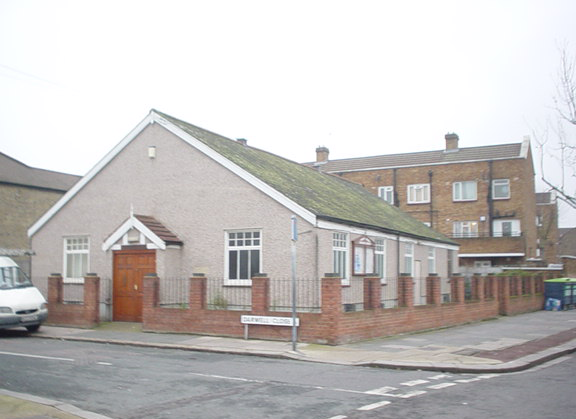
Charles Howe came as a layman from East Ham in 1897 to visit homes and distribute tracts-and stayed on for 53 years. Led by him, the Bonny Downs Mission held open air services and Sunday schools, visited homes and led people to faith in Jesus. In 1900 the work moved into a rented room in a shop on the corner of Flanders Road and Darwell Close opposite the present building.
In 1908 20 members with 6 deacons led by Pastor Howe formed Bonny Downs Free Church. In a converted shop the services and Sunday School led on to open air preaching and house to house visiting. Tent Missions, Girls Club, Womens Own, Young Mens Bible Class, Boys Club and Boys Brigade followed on as out-reach to the wider community.
More houses in the district, growing families and overflowing church premises led to a Building Fund in 1912. Land was earmarked, much fund raising followed and the church was built and opened in 1930 but it took a further 17 years to pay all debts. A large Sunday School-200 children and 30 staff in 1936-and all services and activities - centred in the Flanders Road building.
But Depression in the 1930s, the 1939-45 war and population movement saw the congregation decimated, the work cut back and the building war-damaged. The church joined the LBA in 1946. Charles Howe left in 1950 and died in 1951.
No records exist for the periods 1939-45 and 1957-64 but a succession of lay pastors-Frederick Farthing, F A Claydon and a 'loyal few' held on. In 1969 there were 29 members but no deacons or secretary. But youth work began to grown again after Graham and Ellen Cordery joined in 1967 to begin a life-time association.
Membership remained low and compact for 40 years: 1951-33, 1961-25, 1971-26, 1981-27, 1991-35. Alan Griffith came from East Ham in 1976 to become secretary and lay- pastor and became a long-standing leader. The morning Sunday School of 50-60, an evening congregation of 12-15, the Sisterhood, Girl's Brigade and Youth Club slowly grew. Guest services and coffee mornings reached out. Student pastors from Spurgeons College and the first full-time minister in Kevin Rayfield 1989-91 followed.
Dave Mann 1996-2008 brought vision and enthusiasm and transformed the church. With Sally, he bought his own home opposite the church building and settled into the district. First as part-time, then as full-time minister he led the church into growth and into the community with the theme 'We want to see Jesus changing lives and transforming our community'. Membership trebled to 108 in 2006 and the church took over, renewed and used The Well Community Centre and Flanders Field Sports Centre. In 1998 the Bonny Downs Community Association was formed by local church members to manage the community work.
Worship and work took place at both The Well and the Flanders Road church and the congregation was linked by a network of small church groups. A Portuguese-speaking fellowship led by Edmundo and Olga dos Silva and an Urdu-speaking congregation led by Bashir Sadhu worshipped and trained in the church.
In 2005 Richard Marzetti came as assistant minister and took over leadership in 2008. Andrew Hewitt 2005-2012, a London City Missionary, began door-to-door visitation. A new church plant, Bonny Downs North, was formed by 20 of the members in 2007 and met in the Flanders Road Pavilion led by Ben Clark, another London City Missionary until it closed in 2012. Dave Mann moved across Newham to the Britannia Village church plant in 2008 but remained chair of the Bonny Downs Community Association. He later returned to become co-minister of the church with Sally Mann. The book Looking for Lydia by Sally Mann tells the story.
The centenary of the church was marked by the publication of 100 years of Bonny Downs-a history of Bonny Downs Church 1908-2008 compiled from church minutes and records by Wendy Mann- and a street party for the church and neighbourhood in Darwell Close. A move towards the building of a new church then began and plans were drawn up by the Building Futures group.
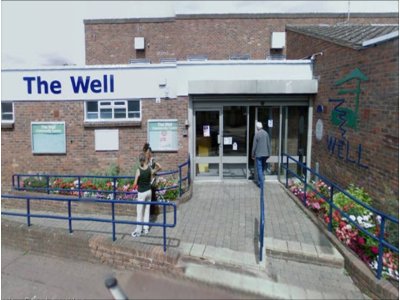
STRUGGLE IN DOCKLANDS
In the south of Newham, between the Thames and the A13 road, industry and the docks built their own housing estates for their work-forces on the former marshlands with industrialists often providing community and church buildings.
In these working-class districts Baptists struggled to settle and survive. Four small congregations were established between 1888 and 1911. New Beckton was a branch of Woolwich Tabernacle, across the Thames. West Silvertown; Wythes Road, Silvertown and Custom House were founded or maintained by West Ham Central Mission. The 1939-45 war closed West Silvertown, Wythes Road shut its doors in 1974 and New Beckton was lost in the Docklands redevelopment by 1978. Only Custom House has survived and in the last 20 years has grown rapidly.

Baptists came from the Woolwich Tabernacle, crossing the Thames on the Woolwich Ferry to share in 'church plants' in Docklands. There they were joined by workers from West Ham Central Mission.
WYTHES ROAD SILVERTOWN E16 stood in the shadow of the giant Tate and Lyle factory. Set in Docklands, perched between the huge docks and the Thames and always dependent on stronger churches, it struggled, dwindled and closed. Built in 1887 to seat 650 it was never autonomous. Early ministers T G Pollard 1892-98, W E Norman 1906-14 were supplemented by students from Spurgeons College. Across the Thames, Woolwich Tabernacle had members in Docklands and were involved but underlined the link with WHCM:
`there was the daughter church at Silvertown, formed with a nucleus from Parsons Hill when conditions looked so hopeless and the hall they used was so dilapidated....today, Silvertown has a beautifully cared for Baptist Chapel. The real minister is Sister Vera of West Ham Central Mission, who has made Silvertown the centre of her devoted service for 20 years'
The annual reports of WHCM list Wythes Road as one of the branch churches from the 1920s. Muriel Forrest from WHCM was the last worker in the Womens Meeting there in the 1960s and 70s. Jim Barclay, from 1971, combined the pastorate with Custom House but his departure led to the decision by WHCM to close in 1974.
Six young people were taken to the nearby St Johns-where one went on to become an Anglican vicar-while the older members were taken by mini-van to the Plaistow church. The site is now an open grass patch, sandwiched between the old Tate and Lyle factory and the busy London City Airport.
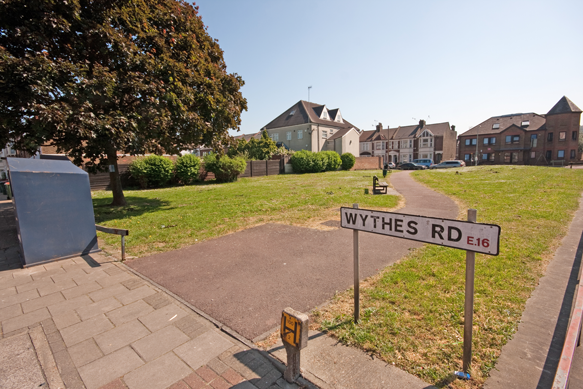
A mile away the smaller WEST SILVERTOWN North Woolwich Road E16 was built in 1903 to seat 250. There is a reference to a Baptist Tabernacle on the 1893 Ordnance Survey map beside the North Woolwich Road which may have preceded the West Silvertown church but no record can be found. The Primitive Methodists were the only Free Church group to make an evangelical impact on the district from the 1880s- a working class movement forming groups in local factories, renting houses for meetings and engaged in open air preaching, street processions and house to house visiting. The huge Docklands Settlement in Canning Town, catering for 10,000 members, provided for community and social needs. The Baptist church struggled to survive.
The 1903 building was sandwiched between the Thames-side industries and the Royal Victoria Dock on the main road between Central London and the factories and docks. It had short-lived ministries-George Hirst 1910-12, R B Hoyle 1913-15, gradually withered between the two wars and by the 1920s was a branch of West Ham Central Mission serviced by the ministerial team from Plaistow. The church closed on the outbreak of war in 1939 and the site was sold.
Sixty years later, after the closure of the docks and the redevelopment of the district Baptist work began again in Britannia Village, Royal Docks.
NEW BECKTON was built on Port of London Authority land and planted in working class Docklands. It flickered, remained dependent, was finally caught up in the Docklands re-development programme and was arsoned in 1978.
This picture and summary comes from East Ham, written by local historian Stephen Pewsey, who also includes the East Ham Baptist building among 11 churches.
In 1888 a building seating 300 was erected in Beaconsfield Street E6 for the incoming dockers and gas-workers on the Cyprus estate. It was known as 'The Old Green Chapel' because of the colour of the paint on the corrugated iron building.
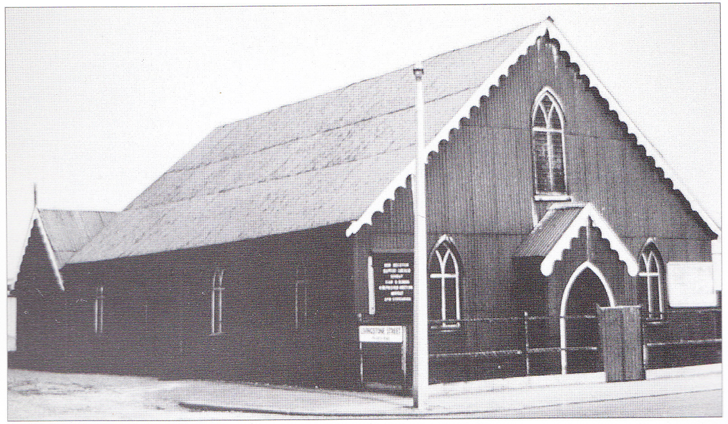
New Beckton Baptist Church. This iron church was built in 1888 in the Cyprus estate and was affectionately known as 'The Old Green Chapel'. Burnt down by arsonists in 1978, its alter cross was plucked from the flames and now stands in the new ecumenical church of St Mark, opened in 1987 in Tollgate Road, Beckton.
Woolwich Tabernacle was involved from the beginning- 'Across the river was New Beckton, then a district without church or school. One of the members moved out there and, finding the need, determined to start a Sunday School. There was no hall available so he gathered the children together in a field. From the field they progressed to a carpenter's shed, lent to them by a builder's foreman. After the loan of the shed services were started for men and women and so the New Beckton Mission was born. A year later an iron chapel was erected'.
It had a difficult history. A small congregation, served by Baptist lay preachers, survived both wars, dock closures and population movement but had dropped to 6 in the 1970s. It was still paying the original rent of £25 a year to the Port of London Authority! Led for many years by the Staple family, supported by a committed nucleus of older women the church, surrounded by pre-fabs,t was eventually the only place of worship.
It became the centre of Christian activity in East Beckton in the 1970s as the Dockland development programmes began. Youth work, a Children's Club and a Sunday School began in 1976 with Sally Karselis of the Newham Community Renewal Programme. Membership grew to 14 with 20 children. With Baptists focusing on Custom House, and Methodists representing the Free Churches in East Beckton, Colin Marchant became oversighting minister in 1978, when the Newham Churches Dockland group took over with an Anglican priest starting pastoral work and the Methodist Ken Start leading services. The Baptist Times reported: 'Colin Marchant...chairman of the Newham Churches Dockland Group said that in Docklands the church's tide is still a long way out. Almost all the existing churches had closed and the New Beckton Baptist Church was the only church building in nearly six miles of dereliction'.
The final service was a commissioning service on October 3rd 1978 for the Anglican and Methodist ministers taking on the work-two days later the building was arsoned. The work continued in the nearby community centre and then in a portacabin until the ecumenical St Marks Centre used by the East Beckton Anglican, Roman Catholic and Methodist congregations opened in 1987-with the wooden cross from the Baptist church.
CUSTOM HOUSE Prince Regents Lane El6 is the only Docklands Baptist church to survive through the difficulties of the 20th century- and then grow dramatically in the 21st century through immigration and black leadership.
Custom House Baptist Church 1915-1965 by Don Clarke has the history. Although the present building seating 250 was built and opened in 1915, local work began much earlier. In 1906 a Sunday School staffed by the London City Mission in Varley Road started in an upstairs flat at 151 Jersey Road. In 1908 some former Congregationalists joined in after their building was burnt down. In 1911 an iron building was erected and a congregation gathered-initially as a branch of West Ham Central Mission under R Ronald Williams. The church became independent, formally constituted, and joined the LBA with 19 members, with 3 deacons and minister R Birch Hoyle in May 1915.

Hoyle, previously at West Silvertown for 2 years left abruptly in June 1915! F W Gubbins, a deacon of East Ham, was lay-pastor for 1915-16 followed by Henry Fuller Moths 'merchant, mayor and minister' as lay-pastor 1916-18. S M Edwards, from East Ham, then became Superintendent followed by Sister Laura Smith until 1921. Two years of student pastorates from Regents Park College [then in London] ended as T J Pennel came as minister 1923-30. By 1925 there was a Sunday School of 500 with 50 staff. A new church building opened in 1928 with 50 members.
The 1930s and 1940s were difficult times-hunger, poverty and unemployment in the district were followed by war-time bombing. The building was wrecked in 1940, re-constructed in 1950 and re-opened in 1952. Loyal members during this time included Mary Phillips, Secretary 1915-1939 Henry Ambrose, a deacon 1915-1963 and George Sabeston the Treasurer 1925-56.
Ken Parkhurst 1932-38 had a significant ministry. By 1936 73 new members, a Sunday School of 400, the Young Mens Club and an annual summer camp for youth led to a peak membership in 1939 of 118. J P Hillerton came on the outbreak of war in 1939, the manse was bombed and the church wrecked but services were held in the next-door Public Library. 'The war years dealt severely with the Church. A thriving, vigorous, pre-war fellowship had been scattered far and wide. A tiny band of stalwarts remained to see the Church through these difficult, austere years'
Norman Giller 1947-54 came to a church with no manse, lived with his parents in Forest Gate and worked in a half-wrecked building. He saw through the re-building, cleared all debts and started youth work leading to baptisms. Don Clarke 1958-66, had to live at 365 Barking Road E13 [West Ham Central Mission property] until 1962 as the church was without a manse. The Evening service became the key congregation as the Sunday School moved to the morning. In his time ebb and flow in both youth work and Sunday School ran parallel to a steady 40 strong congregation with 2 deacons.
Membership continued to shrink from 100 in 1941 to 50 in 1951 through 33 in 1966 to a low-point of 9 in 1981. The church was dominated by the Payne family through the 1960s to 1990s-they provided secretary, treasurer and Sunday School superintendent. Jim Barclay, in a shared ministry with Wythes Road, Silvertown, became pastor from 1971-74 as the docks closed and the population shrank.
As the Dockland development began in the late 1970s Custom House, with 13 members, became the agreed centre of Baptist work within the Newham Churches Dockland Group and the area became a Local Ecumenical Project. In 1978 the Baptist Times reported:
`This church has stood firm through the sweeping tides of demolition and change and in the last year has been completely re-decorated and now a new roof has completed the preparation for a new chapter of outreach'
Richard Walker from 1974 and George Pickton from 1978 came from the Plaistow team. George Pickton became lay-pastor in 1978 in an ecumenical partnership with the Anglican Ascension, sharing buildings and worship. Peter Purkiss 1985-1990, continued in the Local Ecumenical Project [the only one in Newham with Baptist partipation], renewed the buildings and built the membership to 24. Sharing in the gathering tide of Urban Mission, he co-led the London Evangelical Coalition for Urban Mission and became LBA President 1989-90.
In 1992 the church called two men to be joint-pastors. Both were already members of the congregation. Geoff Thorington-Hassell had already moved into the area in a personal commitment to urban mission. Claude Mereweather-Thompson came from Sierra Leone and had already trained as a Methodist minister. The two men shared a £10,000 income and maintained a programme of house groups, children's work, social concern and evangelism until 1995. The area changed with Excel rising from the docks, tower blocks replacing terraced housing and the white working class replaced by an increasingly multi-racial population.
Tade Agbesanwa, a former member of the congregation, became pastor in 2001 and has moved from part-time to full time minister supported by the congregation. Now 'a purpose-driven church' with two hour long morning services with stress on Bible Study and prayer, membership rose dramatically to 103 by 2007. The congregation became largely black, family orientated, multicultural, with 15 nationalities and 60% drawn from the neighbourhood with a high turn- over through migration. Now making efforts to connect with the whole community the church caught the attention of The Guardian in 2011. In an article 'This church is for everybody' Tade Agbesanwa said:This is largely a white working class area, We are an 85% black church based within the community' Now called' The House-a place for Faith and God' the building has a Day care centre called Noah's Ark and re-development is planned. Other congregations have used the premises-Hope Assembly until 2006, Christ Family since in 2007.
NEW BAPTIST CHURCHES IN NEWHAM
A second wave of 10 Baptist congregations has emerged in Newham alongside the 9 older churches established before 1908. They are part of over 200 new, evangelical, and mainly Pentecostal congregations drawn from a growing immigrant population that have sprung up in Newham since the 1980s and 90s. Those joining the LBA and BU range from Calvary Charismatic Baptist Church which began with 30 members in 1994 to rapidly reach 1800 members to the multi-racial, largely Asian, I HOPE congregation meeting in a converted shop gathered over a 10 year commitment by a missionary from the USA.
There are other Baptist 'church plants' with very different stories involving the LBA, Urban Expression and Romanian Baptists. Three have moved on to other London Boroughs, one has closed in unhappy circumstances. These new Baptist churches have emerged within the continuing immigration, growth of population, large-scale regeneration and multi-faith community that have made Newham one of the most culturally diverse parts of the UK with over 100 languages spoken.

CALVARY CHARISMATIC BAPTIST CHURCH [CCBC] arrived in 1994 'to invade the East End for Christ' as a church plant from the Trinity congregation in West Norwood, South London which h sent 30, mainly Ghanian, members led by Francis Sarpong to Newham. From 1994 they used the Atherton Community Centre in the Romford Road, Forest Gate E7, then in 1995 moved to the Stratford Business Centre E15 before setting up their HQ [pictured]- called Calvary Temple- in a converted garage at 269a-279 Barking Road Plaistow E13, next door to a mosque in a former Jewish synagogue. Backed by the LBA with financial loans and support, the church opened with much local and denominational publicity. 'Take the East End for Christ' was the Baptist Times headline over pictures of Douglas McBain, the LBA Regional Minister, under the banner 'Our God Reigns'.
The magazines of CCBC reported Sunday services in Swahili, French,Twi, Lingala and Kikuyu with Youth, Friday Prayer and Saturday Deliverance services. Large Conventions marked by visiting preachers, tents, choirs and prayer gatherings led on to training courses. The launch edition of the CCBC magazine listed Birth, Bereavement and Welfare Committees and groups for Marriage Counselling, the Homeless, Elderly, Drug Addicts, Youth, Kids and Nursery. Auxiliary Ministries for Men, Women, Youth, Children and Ushering ran alongside Calvary Music Ministry, Testimonies and Outreach Africa. 'The Calvary World-wide Outreach reaches the world with the Gospel via radio, short wave, or television broadcasts in every nation'
Frances Sarpong is the senior pastor. He exercises over-all leadership with 40+ supporting ministers ordained within the church-some are full-time, most are in 'tent-ministry', including women. They hold the network of branches together through services, house groups and visitation. The Calvary School of Ministry trained leaders using Delta courses from 2001.
Alongside the main HQ in Plaistow, there were 2 CCBC branches in Newham at Forest Gate, initially in Durning Hall E7 and then Woodgrange from 2010], and Beckton, meeting at New City School E13, by 1996. Other Branch churches, each with Charis in their name, spread beyond Newham and were listed in the 2005/2006 BU Directory at Barking, Elephant and Castle, Hackney, Kidbrooke, Leyton and Woolwich CCBC was possibly the biggest Baptist church in Europe and, with Trinity, made up 25% of the total LBA membership.
Membership growth was phenomenal by UK Baptist standards. The initial 30 rose to 100+ by 1995, 824 in 1999 and 1307 in 2002. There were 84 baptisms in 1995. This was noted by the Baptist Times in 2000 —`From 0 to 800 in six years'... '30 new attenders every Sunday'...`On Millenium Eve 79 people were baptised'. By 2003 congregations were drawn from over 20 nations and national flags flew on outside railings or flanked the platform. In 2007 CCBC moved the central office and main worship centre to Trinity Methodist, Commercial Road Poplar E14 in Tower Hamlets leaving two branches in Newham and selling the Barking Road premises to the Redeemed Church of God.
In the UK CCBC is part of the 'black-majority' church movement drawn together in the Evangelical Alliance Afro-Caribbean Alliance and, among Baptists, the Progressive National Baptist Convention UK. Globally, CCBC had connections and branches by 2001 in Ghana-Calvary Messianic Church in Accra and CCBC in Kumasi; Zimbabwe and Kenya.
CCBC were not alone. From the late 1980s church planting courses, notably at Spurgeons College; over-arching groups like Urban Expression and, above all, the arrival of African Christians led to a surge of emerging churches. Congregations began to appear in homes before renting time in local halls, community centres and within established Protestant churches. Often gathered from across London and even the surrounding counties, shaped by culture and language, constantly moving premises, they centred around strong leaders but often had little to do with the neighbourhood where they worshipped.
Two early Baptist examples that began in Newham and moved to other London Boroughs are Victory Life and Faith Temple Mission. VICTORY LIFE was a very different, individual Baptist church plant which has already used Methodist and Salvation Army premises and moved across London Borough boundaries. In 1997 Samuel Agyeman, who had trained at Spurgeons College, gathered a group that met initially in the Forest Gate Methodist Church, Woodgrange Road E7 and had 18 members by 2001. In 2005 the church took over the former Salvation Army premises at 156 Globe Road, Bethnal Green E2. In 2006 membership was 50 and in 2012 it was 180. FAITH TEMPLE MISSION also used the premises of a settled local church as a springboard. Faith Temple was a congregation, led by Obeg de Lawrence- using the Major Road, Stratford church in the 1990 and 2000s.
An ecumenical effort in the south of Newham by the Royal Docks followed the closure of the docks and the building of new homes. In 1997 the West Silvertown Urban Villages Project appointed an ecumenical development officer in Graham Routley, a Baptist minister then working in the Beckton Ecumenical Centre. This was a short-lived effort with a part-time worker and by 2000 the project disappeared with the departure of the leader. The arrival of an LBA sponsored initiative quickly followed.
BRITANNIA VILLAGE ROYAL DOCKS COMMUNITY CHURCH was, with Quaystone, across the Roding in the Isle of Dogs E14, a London Baptist Association church plant-`a new church for a new millenium' for the Thames Gateway development, launched with an 'appeal for £250,000 to buy two houses in which to start church plants' Without a building, set in a district of continuing change and against a long-standing history of difficulty in the old Docklands districts the pioneer leaders have become community leaders but have struggled to build 'a vibrant new church'.

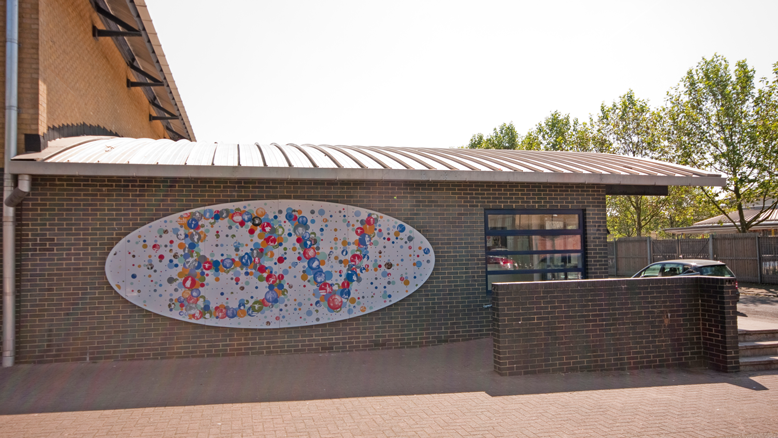
A house in Gatcombe Road E16 was purchased as the base and Penny Marsh 1998-2007 became part-time minister appointed as 'Church planter for the Royal Docks' under the Home Mission Fund- to establish a vibrant new church serving the communities of the Royal Docks areas'. The core values were 'biblical teaching ,caring community, breaking bread together, prayer, mission and growth. community of faith, celebration and praise, commitment to local community'. By 1999 5 adults were meeting weekly in a home group followed by an Alpha group. In 2000 monthly celebrations were held in the local school hall and a leadership team was appointed in 2001. By 2002 the 25 strong weekly Sunday meetings and a home group of 16 led to the formation of a church that joined the denomination.
The associated Bridges Community Project, officially launched at the local community centre in 2004, followed a survey that led to a £45,000 community and family project with a manager in partnership with the Shaftesbury Society. The local Primary School was being used for Sunday services and membership was 15 by 2006 when the church began to worship in the Britannia Village Hall just before Penny Marsh moved on.
Dave Mann came from Bonny Downs in 2007, initially working full-time in re-creating and managing the community centre. A fresh start followed in the planting of a church. Sunday worship ceased, with a group of worshippers going to Bonny Downs, and a new home group began in Gatcombe Road. A web-site 'Faith in the Dock' was launched by Sally Mann to spark debate, raise local issues and create awareness of faith groups. By 2011 the 'Kingdom ministry' in 'a needy, transient and divided community' covered parents and families, children and youth with 'breakfast and prayers' for women on Friday. Still oversighting the community centre, Dave Mann moved to part-time work there in 2011 and, with Sally, began Sunday evening services, launched home groups for men and women and began baptisms.
The church planting agency URBAN EXPRESSION[UE] began work in East London in 1997 founding 3 church plants in Tower Hamlets. By 1999 the UE Up-date reported two initiatives in Newham: 'Forest Gate. The team here consists of one family although more are beginning to be drawn into this work....The aim in this area is to plant a church in the Pakistani community' and `Canning Town....a small group of local Christians who have been meeting together in a home...have asked to join UE. We hope to recruit new members to strengthen this work'.The Forest Gate initiative led on I-HOPE and the Canning Town conversations supported Penny Marsh at Britannia Village and met with a small group of local Christians in Canning Town. Later another Newham church plant, Harvest Rock, linked with UE.
HARVEST ROCK COMMUNITY CHURCH lasted for 6 years and had 4 meeting centres. Nigel and Doreen Westley began this church in their Plaistow home in a tower block of flats in 2001. A hall in Eastlea School E15, the URC New City Christian Centre and finally Bignold Road, Forest Gate E7 became centres for the growing congregation. Linking in early with the church planting agency Urban Expression and joining the LBA in 2004 it recorded 43 members by 2006-many of whom were travelling in. But the church was disbanded in 2007 when the minister was sent to prison with disastrous publicity and headlines in the local paper-`Child sex abuse minister is jailed' A small cell-group of 9/10 adults tried to continue in homes.
Christians with African, Asian, USA and European roots are behind four other significant church plants. VICTORY FAMILY CHRISTIAN CENTRE is a church plant led by Fred and Annie Onwuchekwa 'to share the good news of Jesus Christ with the community of Forest Gate and beyond'. From 2003 a hall was rented in Elmhurst Primary School E7 and the congregation joined the LBA. In 2006 membership was 50 and the church was engaged in services, Bible Study, Intercessor prayer groups, Sunday School, choir and evangelism. By 2007 it claimed to be a 'multicultural church'. In 2010 the church began to use the Woodgrange premises. In 2011 the LBA handbook listed 40 members and the church web-site reported. 'Pastor Annie is also the President/Founder of WODFIM-an organisation of Christian women- and has two branches in North Carolina and New York [USA]'.
Two very different Asian congregations with Baptist links are now meeting in Newham.
The former Grantham Gospel Mission now houses ALL NATIONS- a congregation which took over the building of Grantham Gospel Mission in Manor Park E12 in 2004. Leading elder Bakhtaur Basra, living in Gravesend Kent, gathered an Asian congregation under the name of All Nations which had a membership of 76 in 2001. Although the church is listed in the LBA Directory it is also an Assemblies of God congregation with the trusteeship of the building remaining with the LBA.
IHOPE-The International House of Prayer and Encouragement- was formed and joined the LBA in 2008 following six years preliminary work in the ASIAN FRIENDSHIP CENTRE in Katherine Road E7 which is set in a densely populated multi-racial and multi-faith district. There USA Conservative Baptist missionaries Tom and Barbara Ward have led an independent East London church planting agency since 1998 using their home and the centre in a demanding and long-term ministry.


They worshipped at Woodgrange and, for some years, were part of the Urban Expression network. The Asian Friendship Centre is 'a place to gather, to celebrate culture, to bring different worlds together and for friendship'. It offers computer training, assistance with English, training for jobs and events for women, children and the elderly. It exists 'to promote positive relations in a community, to encourage greater co-operation and understanding and to provide avenues of social, employment and educational support.' 150 people from Muslim, Hindu and Sikh families gathered at Christmas 2008. The BU Directory 2011 has I R Mitchell as the Secretary. `Through IHOPE church and through the Asian Friendship Centre we are asking God to transform men, women and children, whole families'. The 10th Anniversary of the opening of the Asian Friendship Centre was marked in 2012 with a visit from the local MP, Stephen Timms.
The Eastern European BISERICA ROMANA BAPTISTA HANUL with Pastor Teofil Haril began at Strafford Central EIS in 2006/7. The second Romanian Baptist church in the UK, it is a widely gathered church, with Pastor Teofil living in Brixton and the Secretary Casian Sala out at Harold Hill. First listed in the LBA Directory 2008/9 with the BU 2011 Directory giving a membership of 24 with 20 children.
This is the continuing story. While almost all the existing Newham Baptist churches were opening their halls and meeting places to the wave of new churches emerging in Newham-some, like the Plaistow church, to 6 or 7- another group of Baptist church plants sprang up in the Borough. An astonishing variety of Baptist congregations, led by a diversity of leaders, using a range of buildings, with many styles, having rapid growth or failing to take off, moving on or staying put, have sprang up in Newham since the 1990s. Missionaries from the USA, charismatic leaders from Africa and pastors from Eastern Europe have joined with UK organisations and long-established Baptist churches to contribute to the wider tapestry of faith in this part of East London.
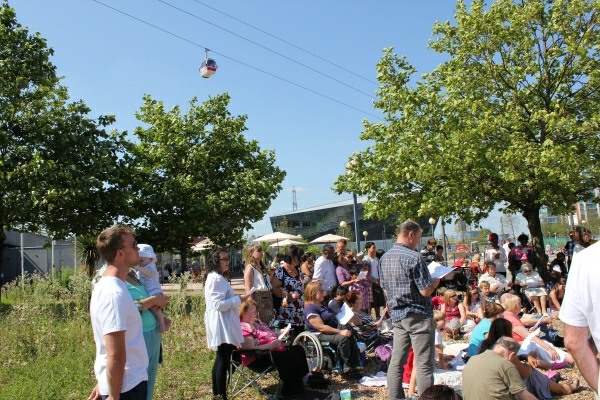
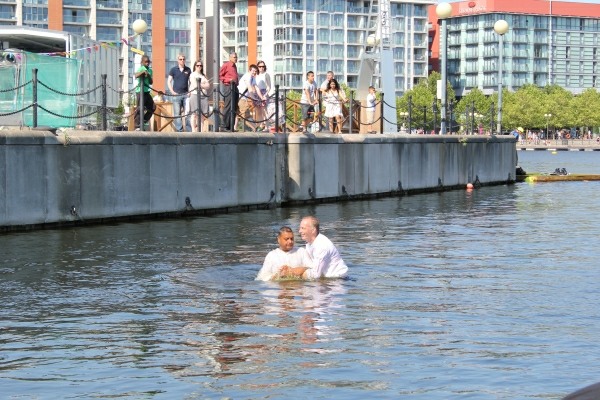
Open air baptism in Royal Victoria Docks on Summer 2012 Royal Docks Community Church for Jay, Becca and Louise.
